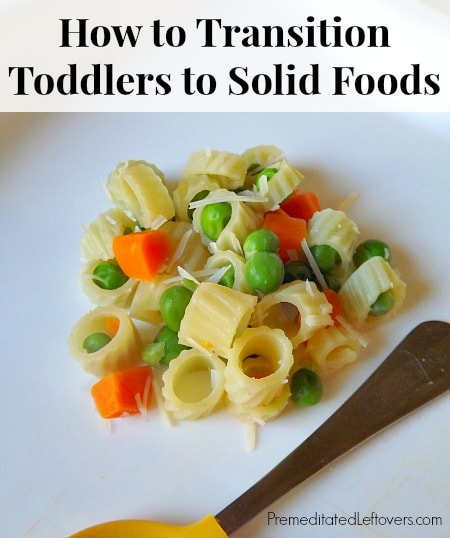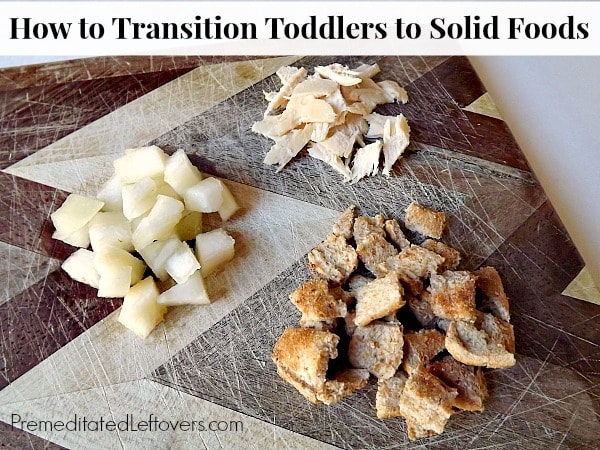If you have recently celebrated the big 1st year mark with your baby, you may be wondering what’s next among their many developmental milestones. In terms of their diet and nutrition, you have approached another important transition: solid foods! Whether you’ve been making your own homemade baby food, or have purchased store-bought varieties, you know that your child has developed many skills in the process. With every bite of puréed food they have practiced their swallowing, chewing, and even using a spoon all in preparation for this next stage. Here are a few tips to help get your started on safely serving solid foods to your growing child.
How to Transition Toddlers to Solid Foods
A one year old can enjoy all of the same fruits, vegetables, meats, and grains you have been serving them in their puréed foods. At this point, parents can skip the purées and serve foods closer to their whole form. However, there are still a few simple steps to be made in order to prevent choking.
• Be sure your child is sitting up securely in a high chair or child seat.
• Observe your child and never leave them unattended while eating.
• Cut all foods into small bite sized pieces that your child can easily grasp and break down in their mouths. There’s a reason we call them “finger foods!”
• Be sure any meat is free of bones or tough skin. Remove tough skin from fruits and vegetables as well if necessary.
• Always check the temperature of foods and be sure they are cooled to a safe temperature for your child.
• Avoid hard, uncooked fruits and vegetables.
• Always remove large seeds and pits prior to serving fruit.
• Avoid seasoning foods with salt, sugar, or heavy spices.
Foods to include as you transition toddler to solid food.
After your child has celebrated their first birthday, they can enjoy a wide variety of table foods. Follow the meal preparation tips above and take a look at these lists to get an idea of what you can now serve your child.
Vegetables & Beans
- Broccoli
- Spaghetti Squash
- Carrots
- Potatoes
- Sweet potatoes
- Corn
- Peas
- Green beans
- Black beans
- Chickpeas
Fruit
- Apples
- Pears
- Peaches
- Bananas Beef
- Raspberries
- Blueberries
- Pineapple
- Grapes
- Mango
- Avocado
- Mandarin oranges
Meat
- Chicken
- Beef
- Ham
- Turkey
- Fish
Grains
- Rice
- Quinoa
- Oatmeal
- Couscous
- Barley
- Bulgur
- Pasta
- Bread
- Tortillas
Dairy
- Whole milk
- Yogurt
- Cheese
- Cottage Cheese
Other foods:
- Eggs
- Tofu
Remember, your child may only be working with a few teeth at this point and they still have not fully perfected their chewing. Not all foods need to be cooked, but cooking foods by steaming or baking is a great way to help soften them up enough to safely serve your child. Grapes should NEVER be served whole as they can be easily lodged in your child’s throat. Don’t worry about low fat or no-fat dairy; milk fat is valuable for brain development at this stage in your child’s life.
Foods to Avoid feeding toddlers:
There is some debate on which foods parents should delay in feeding their children even after 1 year of age. The most common foods to avoid include nuts and shellfish. The theory behind this is due to these foods carrying a higher risk of allergic reaction. Nowadays, some pediatricians take a different stance on these foods and whether or not it’s truly necessary to delay serving them to your child. If you ever have concerns over which foods to include or avoid in your child’s diet, consult with your child’s pediatrician.
Along with common allergens, avoid any foods that cannot be broken down or softened. A great way to test this is to use a spoon or fork to try mashing the food. If it breaks down easily there’s a good chance your child will be able to do the same with their mouths. You may have heard a lot about the dangers of hot dogs, too. Their spongy makeup just makes them particularly easy to get lodged in a small child’s throat. If you choose to serve your child hot-dogs, be sure to cut them lengthwise, and then again sideways into tiny pieces.
How to include your toddler in family meals:
Providing a place for your child at family meals allows them the opportunity to see how others eat, and it allows them to feel included with the rest of your family. While your child can eat many of the foods you prepare for your family, avoid adult foods that contain salt, sugar, and heavy spices. Try to remember to set a portion of your family’s meal aside prior to seasoning or adding anything that wouldn’t be suitable for your child. As your child gets a little bit older, you can start incorporating more herbs and spices into their diets.
In the meantime, you can still mix a variety of foods to make a tasty meal for your child. For example, instead of serving your child a dinner of pasta with alfredo sauce, simply leave off the sauce, mix in a few tablespoons of veggies, and sprinkle with Parmesan cheese. Your child will be able to enjoy the flavors of the pasta, veggies and cheese without the added spices and salt in the sauce.
Portion Sizes:
At one year old, your child does not require the same portion sizes that you and other older children or adults in your family may require. According to the American Academy of Pediatrics, a one-year-old child only needs about 1,000 calories a day. For pasta, fruit, and vegetables a couple of tablespoons is sufficient. When serving meat, try to serve one or two small slices. Trying to push too much food on your child may lead to frustration on both ends, and a lot of wasted food. Offer a wide variety of fruits, vegetables, grains, and proteins and see which ones your child enjoys the most!
Homemade Baby Food Recipes:
How to Make Baby Food Using Fruits
How to Make Baby Food Using Vegetables
How to Make Baby Food Using Meats
How to Make Baby Food with Grains
How to Get Started Making Homemade Baby Food
Emily is a mother of two, Army wife, avid cook, and recently discovered running to help stay fit. She enjoys the outdoors and sharing her knowledge about greener living with others, including cloth diapering and up-cycling everyday objects into something fresh.



Christine (iDreamofClean) says
I found this so helpful! It is so hard to know what to do…what foods to give, etc, etc. I’m always trying to read up on things and figure it out on my own because not sure anyone tells you….or everyone does things different. Thanks for sharing!